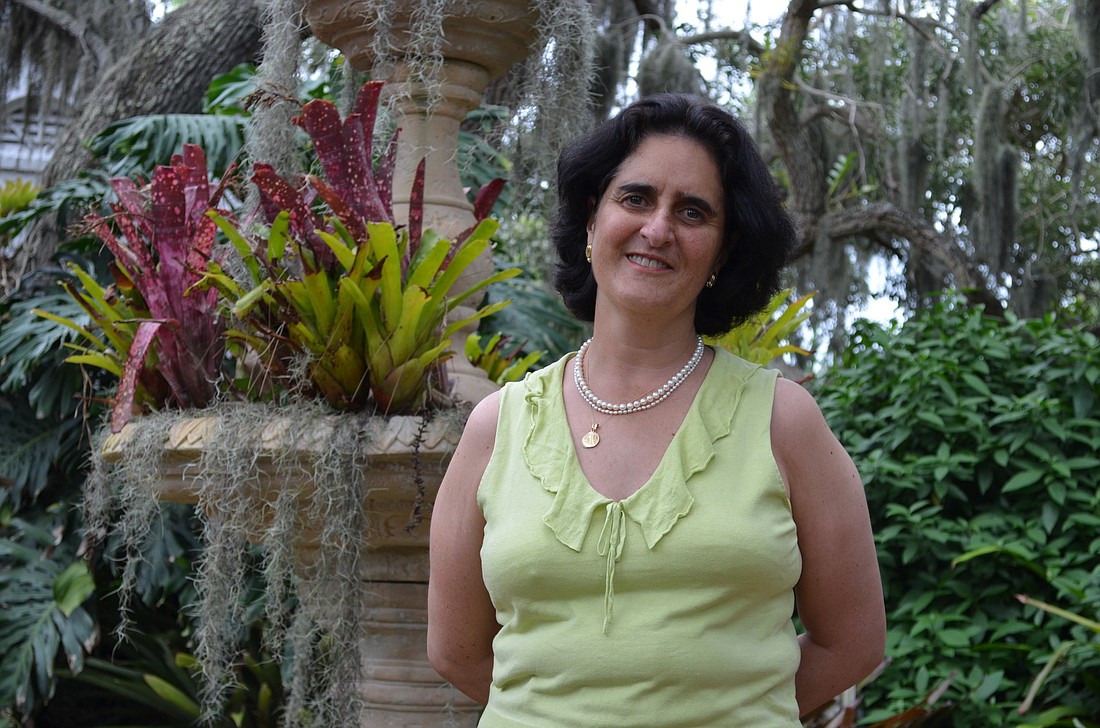- April 24, 2024
-
-
Loading

Loading

Angela Maria Isaza likes to walk Marie Selby Botanical Gardens’ grounds daily when she’s in town. Her familiarity with the flora and fauna is evident.
As she poses for a photo, she admires the look of the Spanish moss, as it lazily hangs in a tree nearby. Isaza then points a finger to politely suggest another spot that makes for a beautiful bromeliad backdrop against the gray sky.
“It’s nice over here,” she says leading the way. After more than 30 years spent exhibiting here, these grounds have become as homey as her native Bogota, Colombia.
A light drizzle turns into a torrential downpour, sending her indoors to the Museum of Botany and the Arts where her colorful batiks adorn the white-paneled walls. Isaza greets a few of the volunteers like old friends before sitting on a nearby bench that’s in view of a handful of her 30-some brightly colored botanical batiks.
Batik is an ancient process of painting wax onto fabric, dipping it in layers of dyes and then removing the wax with an iron and newspaper to create a unique and, in this case, natural-inspired painting. She paints the areas she wants white with wax, dips it in the lightest color first and hangs it up to dry. Then, she paints wax on top of that layer, dips it in the next color, lets it dry, then repeats the process until the painting is finished and she can remove the wax. Sometimes the color that results is unexpected; throughout the process the fabric can wrinkle, creating little lines of dye — but she welcomes these surprises.
Isaza points to a piece hanging above the mantle, one of her favorites, and says that the large orange flower, a fuchsia bloom, the yamas and the little yellow flowers inside of it are from her garden in Bogota.
Isaza explains that she lives with her mother in a home that’s in the city near the mountains. She works from a studio inside her home, but her days are spent working as a full-time architect. There’s a lot of traffic in Bogota, but where they live it’s quiet enough to hear the birds.
“In Colombia, nature is so beautiful,” she says. She describes a winding road on the way to Medellin, where her grandma lived. You can find a yellow blooming jacaranda tree on one street and a purple version on the next street over, with impatiens blooming along the road. She hopes when people see her work that it inspires them to take care of the natural.
Isaza has focused on botanicals ever since her first batik — a butterfly pillow at age 13. She read about the artform in a magazine and found it new and intriguing, so she tried it. The 55-year-old artist has been experimenting with it ever since, though she also enjoys watercolors, oil and experimental fabric work.
The first time Isaza came to Sarasota was to visit a family friend, Betty Burkard. On her first visit, she showed Dr. Kiat Tan, assistant director of The Gardens at the time, her work. He liked it so much he invited her to exhibit the following year, in 1983. She’s been traveling here every few years since then and has exhibited more than nine times at Selby Gardens. Each time her work becomes a little more detailed and complex as she evolves as an artist.
Marie Selby Botanical Gardens CEO Thomas Buchter says they have asked Isaza to keep coming back to exhibit her work because her mission rings true to that of the Gardens’: to further the understanding and appreciation of plant life and the value it has in our lives.
For Isaza, it’s simple.
“Nature makes me happy, and I enjoy seeing God’s work in it,” she says.
Five things that inspire Angela Maria Isaza:
Color — Color is the biggest thing that inspires me. When I see something with one (great) color and how (that) color works with one color and another color (it can be really inspiring).
Plants — How they grow is inspiring. I learn a lot about them (when I paint them). I used to make a little sketch just to see how it grows; if they hang or grow tall. I don’t do that that much now, but just observing them inspires me.
Family — My father (who was also an architect) passed away five years ago, and he was always pushing me to do more and more.
The responses I get — The responses I have had in the exhibit are inspiring. When I come to the exhibits, I like to see people’s faces. And when they’re all happy and, “Wow, how do you do this?” I really enjoy that.
In college, my teachers — My teachers were always very inspiring to me. They encouraged me. When I graduated from art school I got a medal that’s the highest honor in the art department, and that was inspiring.
IF YOU GO
Batiks Botanicos: Viva Florida
When: 10 a.m. through 4:30 p.m. daily through Sunday, Nov. 17
Where: Museum of Botany and the Arts, Marie Selby Botanical Gardens, 811 S. Palm Ave.
Cost: Free with admission
Info: Call 366-5731. The pieces are for sale, and proceeds benefit Selby Gardens’ mission.